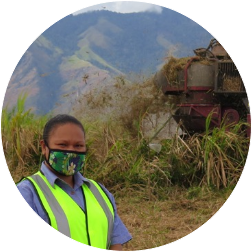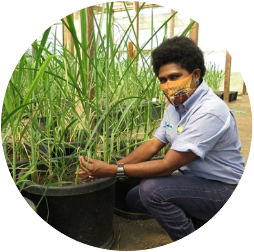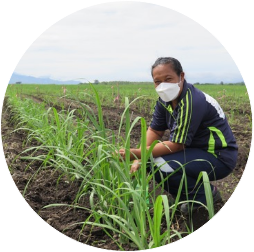Sugar Research
background
Around 6,500 hectares of Ramu sugarcane are harvested annually to produce sugar and related byproducts. To meet annual sugarcane crop production targets (comprised of plant cane and ratoon cane), it is crucial to cultivate varieties that can adapt to local climatic conditions. These need to produce high yields and be able to withstand pests and diseases.
Papua New Guinea is often referred to as the home of sugarcane because several Saccharum species are endemic and widely cultivated in village gardens throughout the country. Native pests and diseases may have evolved in tandem with local production—an unusual scenario that hinders Ramus’s ambitions to be a large-scale agricultural producer.
Since the founding of Ramu Sugar in the early 1980s, local production has been bolstered with extensive research by the company’s scientific staff and external collaborators. Studies have included plant breeding and variety selection, pest and disease control, weed management, nutrition and soil health, as well as other initiatives to improve sugarcane production systems.
Ramu sugarcane production: Main areas of research and development
Sugarcane research and development
Achievements
Plant-breeding research to select locally bred varieties, and the screening of imported sugarcane types, has led to the selection of varieties that are better suited to local conditions and more resistant to pests and diseases at Ramu. Currently, there are around ten commercial varieties in production and four that were developed as local ‘PN’ varieties.
A key plank of Ramu’s sugarcane agricultural research strategy has focused on controlling pest damage. Several studies have investigated the biology and ecology of sugarcane stem borers, white grubs, cicadas, and other insect vectors. Long-term research examined stem borers (Sesamia grisescens), a highly destructive stem pest native to PNG. This led to the successful development and implementation of an Integrated Pest Management (IPM) strategy that involved releasing parasitoids as biocontrol agents, using tolerant varieties, applying insecticides, and other cultural practices.
There has also been a significant emphasis on Ramu disease management. In the 1980s, Ramu stunt disease (spread by leafhoppers) resulted in extensive crop loss. Thanks to concerted efforts at the time, it was possible to control the disease, and it is now less of a threat. In the mid-2000s, ratoon stunting disease resulted in decreased production, but ongoing research in testing nursery cane for planting has helped to stem overall losses.
More recently, PNG has been attempting to combat sugarcane smut. This is being mitigated thanks to the prior development of a national incursion and mitigation plan.
Research has also been carried out to develop optimum fertiliser regimes that enhance sugarcane nutrition and yield. This has entailed assessing the suitability of herbicides for weed management. Subsequently, several biological control agents for managing exotic weeds have been introduced. These include Sida spp., Mimosa diplotricha, and Siam weed (Chromolaena odorata).
Ongoing activities
Ramu Research Services (RRS) currently centers on three key pillars of sugarcane research: Agronomy and variety selection; entomology; and plant pathology.
RRS’s agronomy and variety selection division analyses nutrition, soil health, weed management, and variety selection. It also monitors commercial cane growth and evaluates crop maturity before harvesting.
Ongoing testing of new sugarcane varieties that could be better suited to the conditions at Ramu examines factors such as the potential to be high yielding under rain-fed cultivation. Other aspects include the ability to be pest and disease resistant. After several testing phases, the sugarcane can be introduced as new commercial varieties.
The entomology division assesses sugarcane pest management. In addition to the monitoring and management of pink sugarcane borer (Sesamia grisescens), another pest known as top-shoot borer (Scirpophaga excerptalis) has recently become more troublesome. Researchers are trying to better understand it and develop an IPM strategy to control it and other insects.
Stem borers are regularly monitored throughout Ramu Sugar’s estate, with best management recommendations on controlling them.
Variety selection trials are also carried out to determine the tolerance of different sugarcane varieties against various insects. The objective is to develop high-yielding pest-tolerant varieties.
Ramu’s plant pathology division conducts disease surveys across its sugarcane estates to evaluate the spread of diseases and how to mitigate this. This involves surveying sugarcane nurseries (from where the plant cane billets are sourced) to ensure that disease-free cane is planted across Ramu’s estates.
Selection trials are also taking place to determine the tolerance of different varieties against the various diseases in Ramu with a view to selecting high-yielding disease-tolerant material.
Agronomy and variety selection
Plant pathology
-
Variety testing
-
Downy mildew
-
Ratoon stunting disease
-
Ramu stunt disease
-
Fungicide testing
-
Nursery certification


